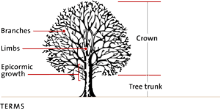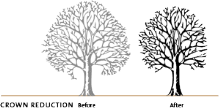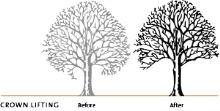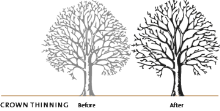For more Information Contact Us on
Office: 01223 426642 Mobile: 07766 176001
Tree care
Terminology - basic tree surgery explained

A guide to various terms to help you make the right choice of service and get any necessary permission from your local council.

1 Crown Reduction
The process of reducing the Crown's overall size whilst maintaining its basic shape. Normal practice is to give a percentage by how much the tree size can be reduced.

2 Crown Lift
Removing the lower branches to give a defined clearance from the ground or building roof line, for example to allow cars or people to pass underneath, or protect a building roof. This is normally defined by the council as a height in metres from the ground.

3 Crown Thin
Removing some branches to reduce the density of the Crown, again this is normally defined by a percentage. This process is to allow more light to pass through the Crown and also reduces the risk of wind damage by allowing the air to move more freely.

4 Pollard
Removing all the branches to leave a bare frame or in some cases just a pole. The pollarding process is only suitable for a few species of trees, most commonly willow. Trees rejuvenate quite quickly and will require similar treatment at regular intervals. Pollarding is a very good way to maintain the size of trees that grow very quickly and will produce a great natural shape.
5 Epicormic Growth
These are the unsightly small shoots that grow up around the base of the trunk and sometimes around branches. These are removed to give a clean and neat look to the tree. Trees often produce epicormic growth when they need more energy or may be under stress, for example if they have had their branches removed.
6 Dead Wooding
The removal of any major dead branches from the tree
7 Felling
Removing the tree completely but leaving the stump in the ground.
8 Stump Grinding
Grinding away the tree stump so that you can turf or plant shrubs in place of the tree. Please note that this process does not remove all the roots, just the main stump of the tree.
Laws and Permissions
Every Council in England will have a tree specialist associated with its Planning Department and you may need permission to carry out any of the processes described above. PA Tree Care can get the necessary permissions from the Council on your behalf as part of the services we offer. Below are some of the main terms relevant to the legal issues regarding trees.
TPO
Stands for Tree Preservation Order. You must gain written permission from your local authority to work on any tree covered by a TPO. From their schedule they can tell you if your trees are protected or not.
Conservation Area
In such an area trees are often given similar protection to a TPO so again permission needs to be gained from your local authority before any work is started.
Boundary Lines
You are within your rights to prune back any trees that overhang your boundary so long as they are not protected by a TPO or in a Conservation Area. You must offer the cuttings back to the tree owner, but if they don't want them you should dispose if the rubbish yourself.
Conifers
The new law regarding conifers is confusing to many people. You do not have to reduce them to a height of 6 foot but you must make sure they are not blocking light to your neighbour's property within reason. There are things to take into account such as which windows are affected, how far the conifer is from the neighbour's property etc. In short it is a matter of being reasonable and considerate.